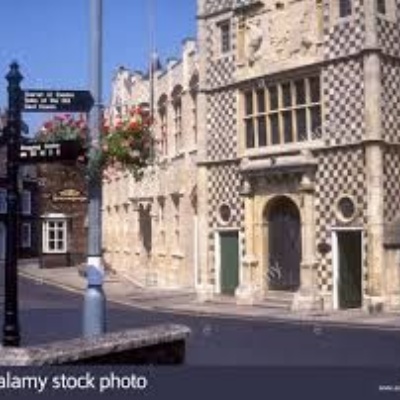Shaping the Nation – St George’s Guildhall, King’s Lynn

St. George’s Guildhall in King’s Lynn is the largest and oldest guildhall in England. For over 600 years it has been adapted and developed to meet the changing needs of life in the town.
For the greater part of its existence, St George’s Guildhall has been a theatre and a place for public entertainment. It was used for plays by the medieval Guilds of Lynn. The first known theatrical production was of a Nativity Play performed before a feast in 1442. This nearly 600 year history of use as a theatre makes St George’s Guildhall the oldest theatre in England. Other special events, such as a supper held for Lady Bardolf by the Mayor and aldermen in 1445 are recorded in the town archive.
Recent academic research has verified that Shakespeare performed in St. George’s Guildhall in 1593 when the Lord Admiral’s Men were visiting Norfolk. The Guildhall is the World’s only surviving theatre where Shakespeare is known to have performed.
The Guild of St George was founded in Lynn in 1376, when the town was one of the most prosperous in England. Lynn had 70 mediaeval guilds that collectively owned vast wealth and played a powerful and influential role in the town.
In 1406, the Guild of St. George acquired land, reclaimed from the Great Ouse, to build its new hall, 107ft long and 29ft wide. It was built between 1410-1420, on two levels with an undercroft venturing into the Ouse to allow boats to moor inside the building and a great hall above that was used for meetings of the Guilds.
By about 1500 it was necessary for five buttresses to be erected against the north wall due to the magnificent roof of trussed rafters being too heavy for the supporting walls. These buttresses are still to be seen outside the Guildhall. The roof is still the original and the rafters can be seen inside the auditorium.
In mediaeval times, the Guildhall was primarily used for meetings, dinners and dances until in 1547, King Edward VI dissolved the Guilds of England.
Reflecting the growth and prosperity of the merchant class in Lynn, in 1560 a local merchant, John Dynnesdale, bought the out-buildings for use as warehouses and the Guildhall itself became known as the Common Town Hall.
Mediaeval Lynn was a cosmopolitan town with strong trading links with the Hanseatic League in Northern Europe and with Spain and Portugal to the South, and past owners of the Guildhall reflect this. In late 1660s it was purchased by the Rotterdam merchant Hubert Vinckesteyn who rebuilt the rear range. Later, the Guildhall was in the possession of Hubert van Vlierden.
Following the Restoration of Charles II in 1660, various performing troupes from Norwich leased the Guildhall from the Corporation during the February Mart.
During the Civil War of the 1640’s, Royalists stored barrels of gunpowder and arms in the Guildhall. And in 1704 there was an unsuccessful attempt by the Corporation to open a button factory. The Guildhall was also home to the County Court until 1767. It had been leased to Joseph Cooper, a painter, at a peppercorn rent for 21 years in 1727 on the condition that he attended to the painting, woodwork, plastering and even gilding.
By 1766, the Mayor found it worthwhile to commission Thomas Sharpe to build a playhouse inside the Guildhall for £450. A model of this theatre was constructed in 1950 and is still kept in the building today.
The success of the Guildhall as a playhouse led to a modern theatre being built in St. James Street and the Guildhall reverted to use as a warehouse when it was sold to William Lee Warner for £557.10.0d in 1814. When his estate was bought by the Lynn merchant family of Everard in 1826, the Guildhall became a wool warehouse.
The Everards, in turn sold St. George’s Guildhall to G. M. Bridges & Son Ltd., scenic artists (for £2,650) who in 1920 were already leasing the premises. Bridges was awarded a Royal Warrant for supplying scenery to the Royal Family at nearby Sandringham, and the crest still hangs in the theatre today. However the impact of Cinema took away much of the firm’s work, and by 1945 the Guildhall was not only derelict but in danger of being demolished for the expansion of a nearby garage.
It was saved by Alexander Penrose, who bought the building in 1951 and gave it to the National Trust who, in turn, leased it to the Borough Council for 99 years until 2050. The input of the Pilgrim Trust, Arts Council and a public subscription led to the Guildhall’s conversion to an Arts Centre and theatre. Queen Elizabeth (the late Queen Mother) opened the venue in July 1951 and launched the King’s Lynn Festival, which has been held every July since then. The Arts Centre Galleries, which were opened in 1963, were converted by the late Lady Fermoy (lady in waiting to the late Queen Mother) as a memorial to her husband, Lord Fermoy, and indeed until recently, the Arts Centre was known as the Fermoy Centre.
In 1997 the Borough Council took responsibility for the programming and operation of the Arts Centre and in 2011 this was taken over by the King’s Lynn Arts Centre Trust. Sadly, the Trust closed in December 2015 and the buildings remain under-used, neglected and in need of modernisation and refurbishment. At the time of writing neither the Borough Council (tenant) nor the National Trust (owner) has been able to come up with a viable plan to secure the future of St George’s Guildhall.
